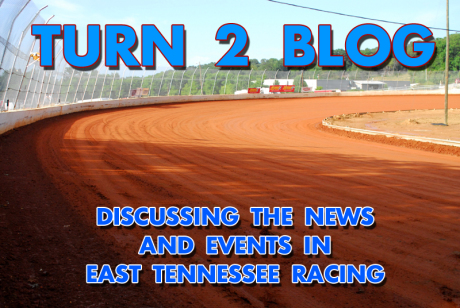*Turn 2 Blog is a regular feature on InsideDirtRacing.com. Here, site operators Michael Moats and Richard Allen take turns offering their thoughts on the dirt racing topics of the day from east Tennessee and beyond.
Richard: Something that has become a topic of interest for me lately has been the procedures the various series use to set their starting lineups for their feature races. There seem to be almost as many methods for determining the starting grid as there are series. This past weekend we saw one of those that is often talked about be used at Smoky Mountain Speedway in the World of Outlaws Late Models event that was eventually won by Scott Bloomquist.
The WoO Late Models typically use a group qualifying format to set the starting lineups for their heat races. Once the heat races are completed, a designated number(often the top-2) from those preliminaries go a redraw in which the drivers blindly pick a number as their starting position. While this format provides drama and intrigue for the fans, it is sometimes criticized by the drivers because of its random nature.
This past Saturday, Chris Madden was clearly less than pleased when he drew the sixth starting spot after having set the overall fastest time in qualifying then dominating his heat race. Ultimately, the Gray Court, SC driver finished in the runner-up spot behind Bloomquist.
At the same time, however, Casey Roberts qualified sixth in Group A time-trials then went on to finish in the second position in the second heat race. He drew the pole position for the feature and went on to cross the finish line in fifth place in the main event.
For series regulars such as Josh Richards or Shane Clanton it would be easy to justify the format by saying that it will all even out in the end. However, a regional competitor such as Madden might not agree, especially after having a similar thing happen to him the previous night at Ponderosa Speedway in which he drew the eighth starting spot for the feature.
What are your thoughts on the redraw format?
Michael: It’s not uncommon for drivers and fans to disagree on formats. Drivers want the easiest way possible while fans want to see things mixed up a bit. A lot of that comes from what part of the country a person is from. A prime example of that is most series and tracks in the Midwest and northeast run heat races of some form for everyone. There is no locking in of any position. This is even done for weekly races. Mention anything like that in this part of the country, most drivers will act like you speaking of some evil master plan.
I will say this. I don’t mind the World of Outlaws format to a point. Mixing things up a bit is interesting. But taking a driver who has been fast all night and having that driver start in 8th is a little extreme. I am a big proponent of how the now defunct NDRL did their redraw. They took the heat race winners and let them draw among themselves. Typically, a dominant driver could start no worse than 4th. Then, they’d take the second place heat finishers and let them draw among themselves. I think heat race wins should be worth something.
Richard: You make a good point by mentioning the differences between what drivers want and what fans want. Many fans want racing action on the track while drivers want the fewest opportunities to destroy their equipment.
Several of the regional series, such as the Ultimate Super Late Model Series and the Southern All Stars, try to find a balance between the two. Some of the series that race in our area lock in the top-10 or so qualifiers then run a couple of B-main races to fill in the remainder to the field. These sometimes may prove to be little more than glorified hot laps if it is known that everyone at the track is going to make the feature anyway, but fans want to get their moneys worth and on-track racing is the way to provide that.
The series promoted by Ray Cook(Southern Nationals and Spring Nationals) attempt to add another element to the mix by offering a dash race among the top-4 qualifiers. Those top-4 often redraw for their starting spots in the dash which brings in that format as well.
The right answer is probably that there is no right answer. Promoters and the various series just have to take into consideration the desires of their fans as well as the needs of their competitors to ensure a full pit area and a full grandstand.
Michael: I don’t think there is a right answer. The old STARS series used to run a 6-lap, 6-car dash to set the lineup for the first three rows. It offered a bit of excitement and I’d like to see that come back somewhere. But some folks didn’t like that.
Seems like the thing that is becoming more popular now is having dual sets of heat races with passing points. I have not seen one of these races in person, just some video clips. It seems like they provide a lot of excitement because the emphasis is placed on passing throughout the field. But my problem with this format is it can be weird to see a driver win a heat race and then not end up in the main event. And two, it’s confusing for the fans because there is not cut-and-dry way for them to see who is in and who is out. It’s up to someone plugging in the numbers to determine how each driver fared.
If someone could ever come up with a good mix of rewarding drivers for their qualifying efforts and providing something more exciting for the fans than running straight up, I’ll be happy to get behind it.
Richard: It is interesting that there are so many different ways to set a lineup. Since variety is the spice of life, that is probably a good thing. Each series can use their own way of doing it to create its own identity.
To move to a completely different topic, the subject of track and series announcers has been brought up on message boards and other forms of social media over the past couple of weeks. That got me thinking about what I like to hear from announcers.
To begin with, I realize my perspective is different from most because of the fact that I am doing live updates from the races I attend which may require different information than fans in the grandstands. Still, most of the basics are the same.
First and foremost, the announcer at a race track is useless if the PA system is not working or is only sporadic. It is important for the tracks to keep their equipment in working order because few things are more frustrating than watching something take place on the track without any real idea of what is going on.
That said, track announcers have a tough job in many respects. For one, they must be aware that it is important for them to be interesting but at the same time keep in mind that they are not the centerpiece of the show. Disseminating information is their most important duty. Funny anecdotes and pointing out particular people in attendance may serve some purpose but those things should not be their primary focus.
Going hand in hand with providing information should be the awareness that they are working in a challenging environment. Repeating things, such as qualifying times, is not a bad thing when there is the real possibility that what has been said may not have been heard by a significant number of people because a loud car was passing by them when the announcement was made.
Also, I appreciate the announcers who tell the full story. For example, don’t announce that the top-10 will be locked into the feature through qualifying then when the session ends only list the top-2. And, update fans as often as possible as to what format is being employed in terms of qualifying and the number of drivers transferring out of each heat race.
All in all, the announcers at most tracks and with most series do an excellent job under what are often difficult circumstances. What do you like to hear from announcers?
Michael: I’m at a bit of a disadvantage as I’m usually in the infield and often don’t hear what is being said. But if I was somewhere to be able to hear the announcer, basic information as to what is going on is first on the list. Explaining what is taking place or about to take place is important. With so many tracks running at least two types of late model classes, explaining the subtle difference is important too. I can’t list the number of times I’ve heard a novice ask what is the difference between the cars. The comment is usually the same – the cars look the same.
An announcer that doesn’t sound like they are reading off a list when mentioning sponsors or stating upcoming events is also important. The ones that sound the most natural are the ones that are typically the best. That goes to my next point the announcer should be somewhat informed as to who the drivers are, where they are from, and maybe some basic info on those drivers. An announcer that doesn’t follow any racing outside of their own track comes off as sounding clueless when a new driver comes to that track and the announcer doesn’t know one thing about that driver and/or badly mispronounces the driver’s name.
One of my biggest observations is having an announcer that can actually be heard and do so without yelling. Being heard is important. Yelling, like a person is calling a wrestling event, just turns off a certain segment of the fans as well. It can be hard to understand what is being said if the announcer is yelling. Be heard and be exciting, don’t be annoying.






